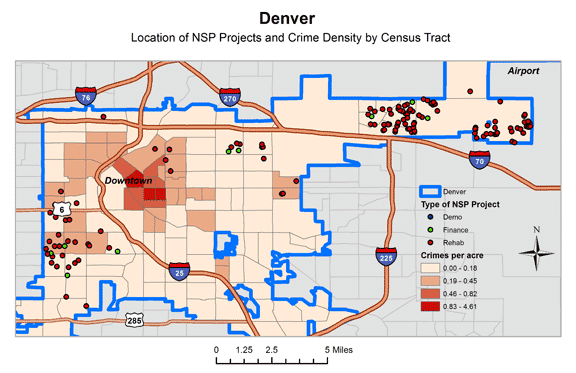 |
by Jon Spader
Senior Research
Associate |
The foreclosure crisis sparked increased anxiety about these issues in many communities where concentrated foreclosures left properties vacant. Indeed, a large and growing body of research indicates that foreclosures caused increased crime during this period, largely as a result of the vacancies that occurred during the foreclosure process. In addition to the possibilities mentioned above, researchers hypothesized that foreclosures might increase crime through several additional channels: falling property values might reduce the local resources available for crime prevention; turnover of neighborhood residents might reduce the extent of monitoring in public spaces; and, reduced maintenance might alter offenders’ perceptions about whether the unit is occupied.
These potential vectors for increased crime raise important questions about what options are available to policymakers who seek to prevent vacant properties from becoming sources of blight to their surrounding communities. A recent Joint Center for Housing Studies working paper examines one possible strategy, measuring the extent to which demolitions and property rehabilitations effectively reduced the incidence of crime on or near foreclosed and vacant properties. Specifically, this paper measures the impacts of demolitions and property rehabilitations funded by the Neighborhood Stabilization Program between 2009 and 2013 in Cleveland, Chicago, and Denver. For more information about the Neighborhood Stabilization Program, additional analyses are available here, here, and here.
These three maps below show the location of demolitions and property rehabilitations in Cleveland, Chicago, and Denver. The number, type, and location of NSP activities are displayed, overlaying this information with shading that illustrates the underlying rates of crime in the neighborhoods surrounding the property demolitions and rehabilitations. The working paper measures the average impact of demolitions and property rehabilitations on the incidence of crime that occurs on the property or within 250 feet in any direction. This distance increment reflects the impact of these investments on the property itself or in the areas immediately adjacent to the property (relative to the trend observed in other areas of the neighborhood).
In addition, the map for Denver shows a small number of financing activities which provided down payment assistance to low-income homebuyers to purchase homes that had recently experienced foreclosure. Unfortunately, the number of such properties is too small to allow similar analysis of whether the reoccupancy of these properties affected the incidence of crime or near the financing properties.
The results suggest that the demolitions conducted by the NSP grantee in Cleveland reduced the incidence of burglary and theft within 250 feet of the demolished properties. The measured impacts of demolitions were present during the period of the demolition and persisted for one year following the demolition, before dissipating. In total, these estimates imply a reduction of just over 1 reported property crime for every 2 demolitions completed.
The findings do not show similar impacts for the observed set of property rehabilitations in Cleveland, Chicago, and Denver, nor for the observed set of demolitions in Chicago. Because the sample sizes are much smaller for these activities, we are unable to determine whether these activities had no impact on crime, or whether this outcome is due to limitations of the study’s data and methods. For example, the set of property rehabilitations conducted in each city, as well as the set of demolitions in Chicago, each included a heterogeneous set of property and neighborhood types, which may limit the estimates of the ‘average effect’ of these investments.
Nonetheless, the findings carry useful implications about the potential for demolitions to alter nearby crime patterns. The direct implication is that a strategy of concentrated demolitions may be effective in altering neighborhood crime patterns under certain conditions. The map of Cleveland above illustrates the extent to which Cleveland clustered its demolition activity, targeting its demolitions primarily to neighborhoods with high levels of vacancy and abandonment. The reductions in crime surrounding these demolitions add to the potential benefits that policymakers should consider in weighing the use of demolition to remove vacant and abandoned properties. The caveat is that the size of the impacts is relatively modest. Policymakers will need to weigh the overall benefits of demolishing vacant and abandoned structures against the costs—which averaged $13,970 per demolition for the NSP program.
Some caution is also needed in applying the findings to other neighborhoods and cities. As the above discussion suggests, the estimates reflect Cleveland’s use of concentrated demolitions in neighborhoods with high levels of vacancy and abandonment and moderate levels of crime. Their demolition strategy might therefore be readily applied to nearby Midwestern cities facing similar challenges, but could be less exportable to neighborhoods with different levels of crime, different built environments, or that are located in different regions of the United States.




No comments:
Post a Comment